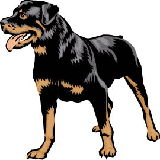Big DogsInformation About The Scottish Deerhound Dog Breed |
|
|
History and origin : Although known primarily as a Scottish breed, Deerhound-type dogs have been around since ancient times. He was bred primarily to hunt with his owner and bring down large deer. This breed has a rough coat that protects him from the cold. Though he is known as a sight hound, his sense of smell is also acute. Description : The Scottish Deerhound stands 30 to 32 inches at the shoulder and weighs between 75 and 110 pounds. He has a lean, athletic, lanky body that is similar to but thinner and slightly shorter than that of the Irish Wolfhound. The Deerhound's shedding coat is medium-length, rough, wiry, and weather-resistant. It requires periodic brushing and an occasional trim. The color may be blue-gray, fawn, light gray, or brindle. About the breed : He is a hardy, graceful, beautiful, and dignified breed that is typically quiet, gentle, and reserved with strangers. Though lazy and easy-going in the home, he does need a daily run to stay happy and healthy. The Scottish Deerhound prefers a quiet, predictable environment and does not easily tolerate teasing from young children. He may also be dog-aggressive and has a high prey drive toward small animals. This breed needs obedience training and socialization from an early age to combat his timidity and increase his confidence. He may bite if scared or annoyed. Training must be slow and precise because this breed learns slowly. Overbearing methods may cause him to panic or become passive-resistant, a condition in which a dog stops thinking and seems frozen. Patience and consistency are required. The "Sit" and "Come" commands may he the hardest to teach to this breed. The Scottish Deerhound usually lives only ten to twelve years and can suffer from bloat or torsion of the stomach, an often fatal condition. To help avoid this, break the dog's feedings down into at least two a day, and soak the dry food in warm water for five minutes before feeding. This will minimize the chance of swelling and of gaseous buildup in the stomach, which is a leading contributor to bloat. Feeding : Recommended feeding for the Scottish Deerhound is 1 ½ - 2 ½ cans (13.3oz) of high-quality branded meaty product with added biscuit in equal amount or 5 cupfuls of a complete, dry food. Ideal home : A house with a fenced yard is recommended for this breed. Keep in mind that these dogs can jump a six-foot fence. The owner of this breed should be patient and easygoing, never harsh, loud, or hyperactive. Pampering types should also pass, as should those who are looking for an extremely gregarious, playful dog. Deerhounds are not recommended for families with young children. The elderly and disabled might have trouble providing this breed with enough exercise. Time to train and socialize is imperative and should begin from puppy hood. Daily exercise is also important; a jogger might enjoy this dog. A blanket or bed should be provided for this breed to lie on because of the lack of fat and muscle padding on his frame.Back to the Big Dog Breed article page
| |
|
Related News About Dogs ' ); // get rid of newsfeed display by carp CarpConf('poweredby',''); CarpCacheShow('http://classifieds.agriscape.com/syndicate/dogs.rss'); ?>
|
|
|
|
|
|
Copyright © 2006-2007 dogguidance.com |


